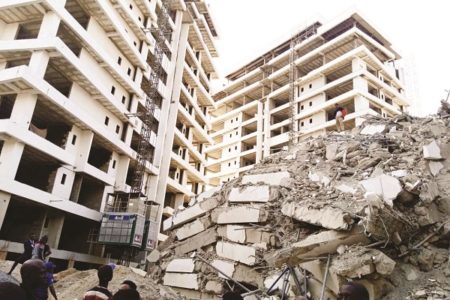
Many atimes, Providence speaks to human beings in anecdotes. Unfortunately, man is too blind to even behold the foot of his nose; too lost in pursuit of earthly existential scrambles that the lessons of these stories are most times lost on him.
Traditional Africa located the power in relating life experiences, as well as the experiences of living and non-living beings, especially those of animals, to the life of existing man. For centuries, not only did humanity learn to live by minding the landmines that consumed its recent and ancient ancestors, it also fashioned its life therefrom.
The holy writs are filled with anecdotal examples of lives lived that ended in perdition and ones lived in exemplary manner that are worthy of being copied. This is the power behind folktales, dreams and historical renditions. Relation of life experiences to occurrences that have happened could even be said to be the philosophy behind the doctrine of stare decisis in law. This doctrine arose out of the need for legal continuity, for the sake of certainty. Inherited from the English common law, in the early 18th century, English courts gave qualified obligation to judges to abide by past decisions and established rules made by former precedents whenever same points and same issues came forth for adjudications.
For a whole one week now, Nigeria has been thrown into mourning. Calamities have befallen Nigeria from all fronts before now but the calamity this time around came from the western flank; from the sudden collapse of a 21-storey Gerrard, Ikoyi, Lagos terrace building belonging to Femi Osibona, owner of Fourscore Limited. As at the time of writing this, 40 people had been pulled out of the debris of the collapse, including the remains of the Property Developer Osibona himself, his friends and workers on site.
Recriminations, blame trading and tar-brushings that bear imprimatur of politics are being spurned. The calamity has been dimensioned severally, from the architectural, engineering, spiritual to the human angles, The question to ask in all these is, could the Lagos 21-stoey terrace building collapse be speaking to a greater rot within, and a greater calamity to come that bespatter our country, which could happen unless Nigeria takes heed?
Put differently, could the collapse actually be a metaphor for understanding a collapse or a likely collapse of Nigeria unless we remedy our national structure? Can we dimension the cracks in Nigeria, taking into consideration the dimensioned fractures that eventually led to the collapse of the 21-storey Ikoyi building, with a view to averting her fall?
Osibona, from all that have so far been said about him, had a good intention for himself as an entrepreneur and a projected, even if ostensible, good intention for the property development world as at the time he conceived of the idea of the Ikoyi terrace building. While many have spoken of how Osibona transitioned from being a shoe, clothes seller in the United Kingdom, into establishing Fourscore Limited, his capacity to be able to build the high rise building cannot be questioned. Is it the same for his capability?
It may be a throwback to that maxim that says the road to hell is paved with a swathe of good intentions. There have been so many good-intentioned projects and projections that have ended in calamitous ruins. While metaphysicists talk about the unseen dimensions of human engagements, as Africans, we will be engaging in a barren venture if we take the route trodden by the Austrian British philosopher, Ludwig Wittgenstein, who maintained that metaphysical matters are nonsensical. For us as Africans, the unseen dictates the template of the seen. In our world, the fly dancing on the river has a drummer hidden from vision, the metaphysics of its being. So, could the crash and collapse of that edifice have had an eidetic significance, far more than the physical lacuna that scientists and professionals have identified as the likely cause of the collapse?
Whatever is the foundational, structural or super-structural errors that led to the collapse of the Ikoyi building can be metaphorized as Nigeria. The 1914 structural and foundational error behind virtually all ills plaguing Nigeria has been underscored severally. While the foundational colonial error of bumping together like and unlike entities into a questionable whole has been identified as a major cause of the debilitating instability in Nigeria today, over a century after, super-structural errors that came thereafter have compounded the ills that plague her.
German jurist, Friedrich Karl von Savigny of the Historical school of thought in jurisprudence, had espoused what he called the volkgeist, the national spirit, as the glue that cements and binds a people together, the absence of which can mar a jurisprudential understanding of a people’s law. In the colonial shell bequeathed to a post-colonial Nigeria, there is a clear absence of the Savigny volkgeist and manifesting in a Nigeria that is an alien and strange contraption that the people have to encounter as a vague reality. This has led to so many crises, ranging from the military putschs of 1966, the pogrom in the north, a fratricidal war, the incidence of military rule, the monumental heists that have been inflicted on Nigeria ever since and the economic stasis, as well as the security challenges that the country is facing today.
There have been so many posthumous accounts of the person of Osibona, the Fourscore property owner. Each of the accounts claimed that he never cut corners and was merely ambitious. However, there have also been other claims to the effect that the initial design of the building was eight floors and that the foundation was not designed to shoulder an edifice of that magnitude.
There was also a viral video of men of the Lagos structural enforcement outfit which stormed the Ikoyi property to bring him to book but from whose hooks he freed himself after pressing the usual Nigerian button. This is a euphemism for graft, bribery and the typical Nigerian big-man-ism. Those who claim that in the button pressed by Osibona which secured him freedom from this harassment could be found a nexus between him and those who he allegedly fronted for didn’t get the dice right. In Nigeria, you do not need to be a surrogate of a super big man to be able to secure freedom from the law. You only need to possess the right stack of cash that can drive the greed of the system and law.
The Nigerian postcolonial burden has ensured that Nigeria is a land of cutting corners. Drugs are fake, human beings are fake, promises are dross, mosques are fake and the pulpit is suffering from a fakery of cataclysmic proportion. When a man approaches you and announces that he is Pastor or Imam, flee. Did you listen to a viral video of Pastor Matthew Ashimolowo sacralizing Osibona and his pursuits? With this, it becomes very difficult to draw a line between devilish, fast-tempoed aspirations and Godly aspirations. By the way, how come that in those moments of laying hands on Osibona to “conquer territories,” Ashimolowo didn’t decipher that a man running at such supersonic speed to conquer property developments in continents could be short-changing the system? Did Ashimolowo caution against speedy sprint of this protégé of his?
Because the putting together of Nigeria lacks the metaphysical or the spiritual element, it then goes without saying that she lacks a major cohesive ingredient that holds a people together in their time of travails. There is no common goal that the people of Nigeria are pursuing as they lack what in German is called Wéltanschauung, a worldview. It symptomizes the collection of values, attitudes, narratives and expectations of the world in which a people are born and which shape them, their thoughts and actions. It is reason why there are variations in the ethos, ethics, religion, philosophy and beliefs of the people of Nigeria.
Many structural engineers have queried the substructure of the land that the 21-storey building was erected. When narratives from the top, especially from those who hold the rein of power today, claim that Nigeria’s unity is non-negotiable, they sound extremely ridiculous like a sub-structural wrong that perhaps the builders of the Ikoyi property noticed but which they believed was immaterial and that a magnificent structure erected on it will cure the wrongs.
Trust Nigerians with their multifaceted prognoses at death, we have been variously told that there was a compromise of quality and standard in the building of that fallen edifice. For instance, a Prowess Engineering Limited, a company that allegedly began the construction of the collapsed building, reportedly warned the late Osibona of the inherent dangers in circumventing process and standard in its construction. In a letter that instantly went viral, the company was said to have withdrawn its services on grounds that there was variation, both in the vision of the company, the late owner’s and the building project.
Likewise in Nigeria. Nation-building is a product of shared vision and is a collective enterprise. The moment there is no Fe of ownership of a national project and there is an absence of a consensus of ideas, cracks begin to appear. In a Nigeria where some people are perceived as lords while others are serfs, where some nationalities are kings and others their servants, the end product is always a disaster.
The administration of Nigeria, especially from 1966 till date, has yielded so many contradictions and ambiguities. Largely due to the selfish interests of the colonizers which were projected in the foundational administration of Nigeria, ethnic groups were thus balkanized as ethnicities and not as nations. This has made issues to be viewed from their ethnic prism and ethnicity used as a negative construct. Any policy, projects, appointments, infrastructure and dividends of governance is perceived and apprehended from the vantage point of ethnicity. This crack has further become more noticeable since 2015 when Mephistopheles gifted Nigeria a president who has offhandedly escalated the importance of where one comes from in Nigeria, higher than what one has to contribute to Nigeria.
Today, apart from all the challenges of making Nigeria a nation-state, Nigeria has become a recipient of dross structural padding that cannot endure. No one administers Nigeria from the position of wishing Nigeria to be great but as a honey-pot from where they could take a lick and bite. There is no synchronization in the expectations, contributions and manifestations of all the ethnic groups of Nigeria. Everybody is merely dancing to the rhythm of their own tunes and beats. The absence of unanimity of purpose has hugely stalled the possibility of nation building.
Thus, impunity is ten a dime on Nigerian streets. From the roads, offices, government, individuals and everybody in Nigeria, impunity has become the necklace we fiendishly advertise. If you come in contact with the disorder on the streets of Nigeria, you do not need to read Karl Maier’s This House Has Fallen to be able to decipher that Nigeria is going the Ikoyi 21-storey building way gradually.
Ostensibly, the fallen Ikoyi building didn’t acquire the liability of a fall overnight. It began to crack within unnoticeably a long time ago. As they say, that Rome was not built in a day, it is obvious that Rome was also not destroyed in a day. That great empire began to stink from within and the crumble began gradually. It is same with a Nigeria that we are cobbling together with great efforts and brinkmanship, without bothering to repair the wonky foundation upon which she was erected.
There are several lessons Nigeria can learn from the Ikoyi fallen high rise building. Nigeria big but fragile and its fragility has prodded many theorists to point at its probable fall. Nigeria’s collapse may not be as structural as we saw in the Ikoyi building’s collapse but the country is getting to a point where its existence is hugely threatened.
If Osibona was told of the fragility of the structure he was putting together yet stewed dangerously in his own broth of self-delusion of the strength of his magnificent structure, he would be in the same parlour with the rulers of Nigeria who believe that some metaphysical glue that has kept Nigeria from falling, right from the civil war period, would always be available to make Nigeria withstand whatever push and shove she gets from as a result of her wonky foundation. It is not too late for Nigerian rulers to avoid a calamity of the hue of Ikoyi if they come down from their high horses, accept that there are structural errors that needed to be corrected urgently about Nigeria and do that immediately.










